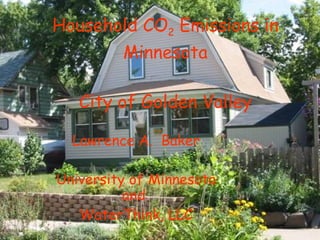
Household CO2 emissions in Minnesota
- 1. Household CO 2 Emissions in Minnesota City of Golden Valley Lawrence A. Baker University of Minnesota and WaterThink, LLC
- 3. Sources of Minnesota’s energy for all uses (1,830 trillion BTUs in 2004)
- 4. Electrical energy production in MN, 2004 (548 trillion BTUs)
- 5. Minnesota energy use by sector, 2004 Minnesota comparison among states : Cost per million BTU, rank: #36 Energy/capita: $2,989 per year ( #28)
- 6. Trend in total energy use in Minnesota
- 7. Trend in carbon fuels in Minnesota
- 8. Trend in per capita energy use
- 9. Per capita consumption has increased
- 10. Percentage of Americans who are “very happy” Is energy consumption making us happier?
- 12. How important are households in the urban context? 90% Trees on private property (national est.) 40-50% N and P 41% Direct CO 2 emissions (national est.) 43% Water use 29% Residential land % for Twin Cities
- 13. TCHEP Goals Inputs Carbon - natural gas, gasoline, food, jet fuel, paper, etc. N and P - human and pet food, fertilizer, etc. Outputs Carbon - CO 2 , garbage, sewage N and P - lawn runoff, sewage, garbage 2. What demographic and behavioral factors control consumption? 1. What are the “fluxes” of C, N, and P, and how does this vary among households?
- 14. Turf Inputs Compartments Outputs Transportation (household vehicles, air, mass transit) Fuel (C org ), Atmospheric N 2 Emissions (CO 2 , NO x ) Household energy (heating, cooling, appliances) Humans Food C org, N org P org Exported garbage C org , N org , P org Wastewater (C org , P org , N org PO 4 3- , NH 4 + ) Respiration (CO 2 ) Atmospheric CO 2 ; fertilizer (N org , NH 4 , NO 3 ) Soil (root zone) Trees External compost (C org , N org , P org ) Pets Export to street (runoff + leaves) (C org , P org , N org PO 4 3- , NH 4 + , NO 3 - ) Paper and plastics Paper and plastics (C org , N org ) Denitrification (N 2 , N 2 O, NO 2 ) Export to vadose zone and aquifer (NO 3 - , PO 4 3- ) Ecological network analysis of a household ecosystem Baker et al., 2007
- 15. Individual choice: Theory of Planned Behavior Anjen and Fishbein (many papers) ATTITUDES TOWARD BEHAVIOR SUBJECTIVE SOCIAL NORMS PERCEIVED BEHAVIORAL CONTROL INTENT TO BEHAVE BEHAVIOR DECISION BEHAVIORAL BELIEFS (KNOWLEDGE) NORMATIVE BELIEFS CONTROL BELIEFS How this might be used: - Identify the key motivations - Identify constraints toward changing behavior - Identify method for providing information
- 19. Average carbon input to Falcon Heights homes
- 21. Carbon consumption varies hugely within Falcon Heights homes 3X!
- 22. Household carbon profiles for volunteers
- 23. Household kg C/person Leif household (4) 1,626 Clapp-Smith household (4) 2,231 Hobbie household (4) 1,648 Single male household (1) 3,450 Grimes household (2) 3,045 Per capita comparison Falcon Heights study 3,440 World (total per capita) 1,193
- 25. Minneapolis GHG emissions inventory, 1000 tons/yr 7% change overall
Notes de l'éditeur
- Environmental psychologists often use the Theory of Planned Behavior as a tool for understanding what factors control behavior. For example, if one doesn’t believe that oil resources are limited, it is unlikely they will feel compelled to save energy. On the other hand, one might “know” that oil supplies are running low, but have a feeling that you can’t make much of a difference by buying a small car – a lack of perceived control. Understanding the specific knowledge and beliefs underlying behavior can be used to develop policies to change behavior more effectively. Kristen Nelson will be talking more about this, regarding studies of household consumption.